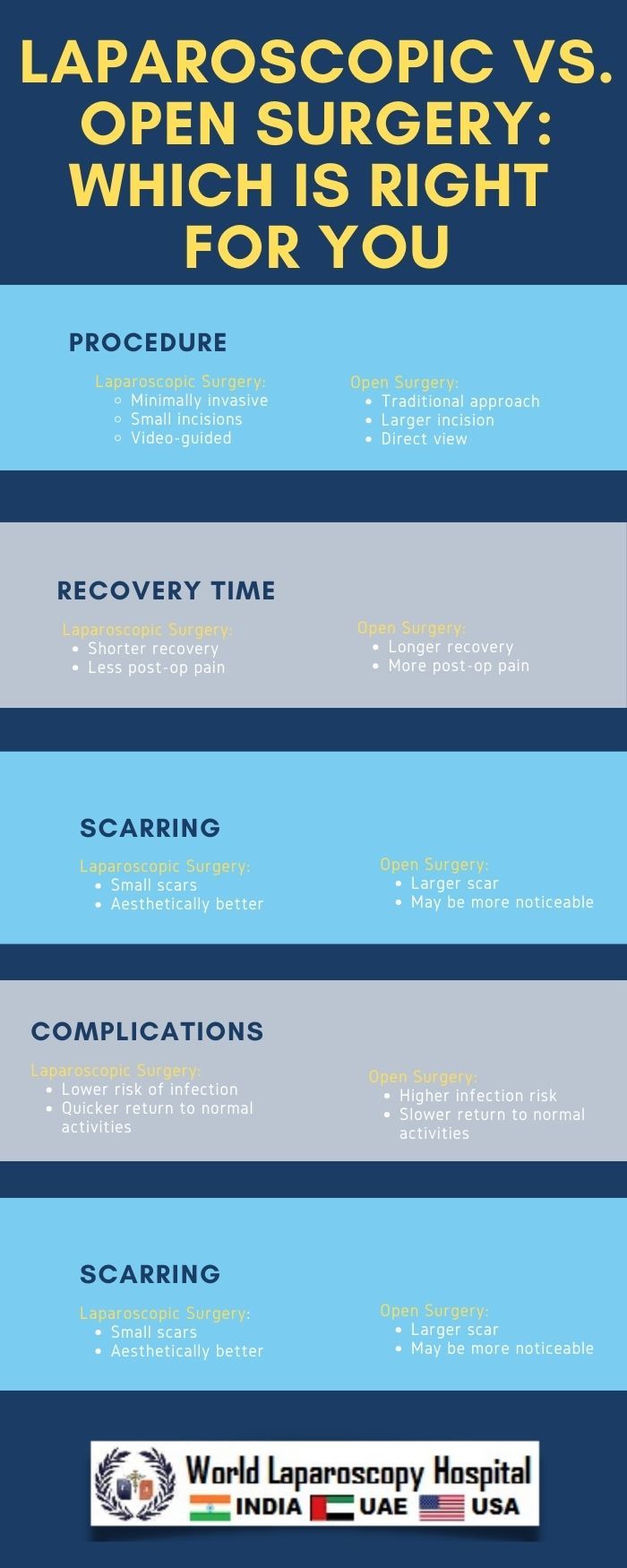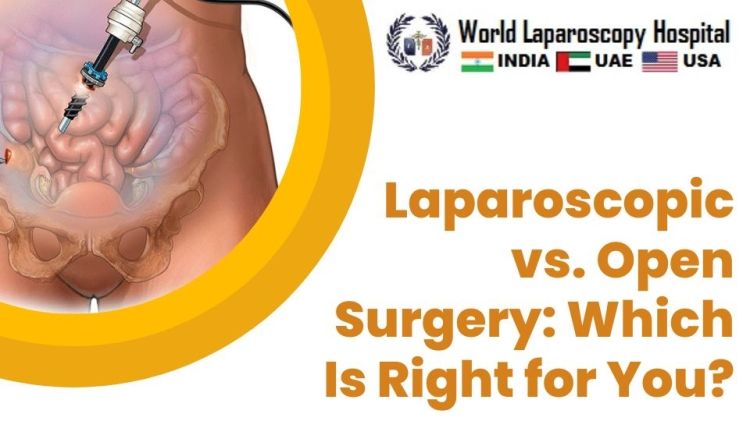Title: Laparoscopy vs. Open Surgery: Which Is the Better Option?
Introduction
In the field of surgery, the choice between laparoscopy and open surgery has been a topic of debate and research for decades. Both approaches have their merits and drawbacks, and the decision on which one to use depends on various factors. Surgeons in Gurugram, like myself, often face this crucial decision when planning a surgical procedure. In this comprehensive article, we will delve deep into the intricacies of laparoscopy and open surgery, comparing their advantages, disadvantages, and the factors that influence the choice between the two.

Understanding Laparoscopy
Laparoscopy, also known as minimally invasive surgery (MIS), involves making small incisions in the patient's body through which a thin, flexible tube with a camera and surgical instruments is inserted. This camera, called a laparoscope, provides a real-time video feed to the surgeon, allowing them to perform the surgery with precision. Laparoscopy has gained popularity in recent years due to several advantages:
-
Smaller Incisions: One of the primary benefits of laparoscopy is the use of small incisions, typically 0.5 to 1.5 cm in length. These tiny openings reduce trauma to the surrounding tissues, resulting in less pain and discomfort for the patient.
-
Faster Recovery: Because laparoscopic procedures are less invasive, patients generally experience shorter hospital stays and quicker post-operative recovery. This is particularly advantageous for busy individuals in Gurugram who want to return to their daily lives as soon as possible.
-
Reduced Scarring: The small incisions in laparoscopy lead to minimal scarring, which can be a significant cosmetic benefit for many patients. This is especially important for those concerned about their appearance.
-
Lower Risk of Infection: Smaller incisions also reduce the risk of infection, as there is less exposure to external contaminants. In a bustling city like Gurugram, where environmental factors can play a role in post-operative complications, this is a crucial consideration.
-
Improved Visualization: The laparoscope provides high-definition, magnified images of the surgical site, allowing for better visualization and precision during the procedure.
-
Less Blood Loss: Laparoscopic techniques often result in less blood loss compared to open surgery, which can be especially advantageous for patients with underlying health conditions.
Advantages of Open Surgery
Open surgery, also known as traditional or "open" surgery, involves making a larger incision to access the surgical site directly. While laparoscopy has become increasingly popular, open surgery still has its place in many medical scenarios:
-
Better Access and Control: In complex or intricate cases, open surgery provides surgeons with direct access to the surgical site, allowing for better control and maneuverability. This can be crucial for certain procedures that require precise techniques.
-
Tactile Feedback: Unlike laparoscopy, where the surgeon relies on video images, open surgery provides tactile feedback, allowing the surgeon to feel the tissues and make adjustments based on touch.
-
Suitable for Emergency Cases: In emergency situations where time is critical, open surgery may be the only viable option. It allows for quick access to address life-threatening conditions.
-
Cost-Effective: Open surgery tends to be more cost-effective compared to laparoscopy, which involves expensive equipment and longer operating room times.
-
Versatility: Open surgery can be used for a wide range of procedures, making it a versatile approach that is applicable to various medical specialties.
Factors Influencing the Choice
The decision between laparoscopy and open surgery is not always straightforward and depends on several factor
-
Patient Factors:
- Patient's overall health and medical history.
- Body habitus and the feasibility of laparoscopic access.
- Patient preferences and expectations regarding recovery and scarring.
-
Surgical Factors:
- The complexity of the procedure and the surgeon's expertise.
- The surgeon's comfort and proficiency with laparoscopic techniques.
- The availability of laparoscopic equipment and resources in the surgical facility.
-
Disease-Specific Factors:
- The type and stage of the disease being treated.
- Whether the surgery is elective or for an emergency.
- The presence of complications or comorbidities.
-
Hospital and Environmental Factors:
- The availability of specialized surgical facilities and equipment in Gurugram.
- The hospital's protocols and guidelines for different surgical approaches.
-
Cost Considerations:
- The financial aspect of surgery, including insurance coverage and out-of-pocket expenses.
Specific Surgical Specialties
Different surgical specialties may have unique considerations when it comes to choosing between laparoscopy and open surgery. Let's explore a few of them:
a. General Surgery:
- Laparoscopy is commonly used for procedures like cholecystectomy (gallbladder removal) and appendectomy (appendix removal).
- Open surgery may be preferred for more complex abdominal surgeries.
b. Gynecology:
- Many gynecological procedures, such as hysterectomy and ovarian cyst removal, can be performed laparoscopically.
- Open surgery may be necessary for certain conditions like large fibroids or extensive endometriosis.
c. Urology:
- Laparoscopy is often used for prostate surgery and kidney procedures.
- Open surgery may be chosen for extensive kidney tumors or complex reconstructive surgeries.
d. Orthopedic Surgery:
- Orthopedic surgeries generally involve open approaches to access bones and joints.
- Arthroscopic procedures are a subset of laparoscopy used for joint-related issues.
e. Cardiothoracic Surgery:
- Open surgery is the standard for most heart and lung procedures.
- Minimally invasive techniques like robotic-assisted surgery are becoming more common in cardiothoracic surgery.
Advancements in Laparoscopy
Laparoscopy has evolved significantly since its inception. Recent advancements have expanded its applications and improved its capabilities:
-
Robotic-Assisted Surgery: Robotic systems like the da Vinci Surgical System enable surgeons to perform laparoscopic procedures with enhanced precision and dexterity. These systems are increasingly used in Gurugram and other advanced medical centers.
-
Single-Incision Laparoscopy: This technique involves making just one small incision through which multiple instruments are inserted. It further reduces scarring and improves cosmetic outcomes.
-
3D Laparoscopy: Three-dimensional laparoscopy provides surgeons with depth perception, enhancing their ability to work in a three-dimensional space during surgery.
-
NOTES (Natural Orifice Transluminal Endoscopic Surgery): This innovative approach allows surgeons to access the abdominal cavity through natural orifices like the mouth, vagina, or rectum, minimizing external scarring.
Case Studies
To illustrate the decision-making process, let's examine two case studies from Gurugram, where the choice between laparoscopy and open surgery played a significant role in the patients' outcomes.
Case Study 1: Cholecystectomy
Patient A, a 45-year-old Gurugram resident, presented with gallstones. After a thorough evaluation, it was determined that she was a suitable candidate for surgery. The surgeon opted for laparoscopic cholecystectomy due to its minimally invasive nature. The patient experienced a smooth recovery, was discharged within 24 hours, and returned to her normal activities in a week.
Case Study 2: Colorectal Cancer Surgery
Patient B, a 60-year-old with a history of colorectal cancer, required surgery to remove a tumor. Given the complexity of the case, the surgical team in Gurugram decided to perform an open surgery to ensure better access and control. While the recovery period was longer compared to laparoscopy, the patient's oncological outcome was favorable.
Conclusion
In the ongoing debate of laparoscopy vs. open surgery, it's clear that both approaches have their unique advantages and should be considered within the context of individual patients and their specific medical conditions. Surgeons in Gurugram, like myself, must weigh various factors, including patient preferences, surgical expertise, and the nature of the disease, to make an informed decision.
As advancements in laparoscopy continue to expand its capabilities, it is likely that more surgical procedures will become amenable to minimally invasive techniques. However, open surgery remains a crucial option for cases that demand the benefits of direct access and tactile feedback.
Ultimately, the "better" option depends on the careful assessment of these factors, guided by the shared goal of ensuring the best possible outcomes and quality of life for our patients in Gurugram and beyond.
